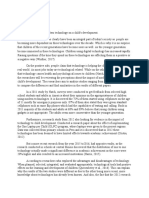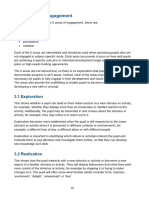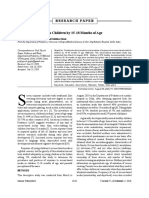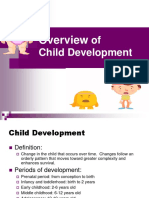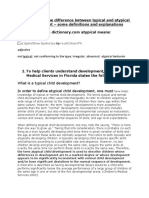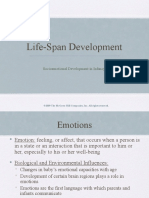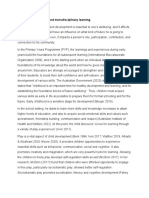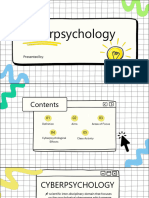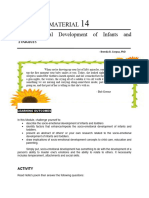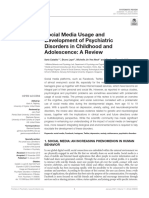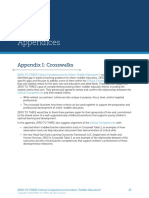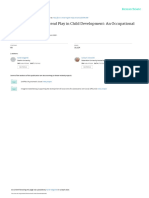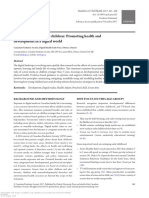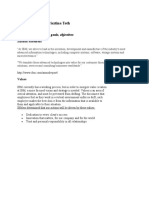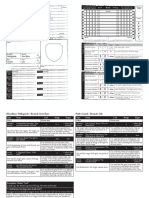Screen Time and Children Development
Uploaded by
jmkg76Screen Time and Children Development
Uploaded by
jmkg76Paediatrics & Child Health, 2023, 28, 184–192
https://doi.org/10.1093/pch/pxac125
Position Statement
Position Statement
Screen time and preschool children: Promoting health and
development in a digital world
Michelle Ponti MD
Downloaded from https://academic.oup.com/pch/article/28/3/184/7163632 by guest on 11 October 2024
Canadian Paediatric Society, Digital Health Task Force, Ottawa, Ontario, Canada
Correspondence: Canadian Paediatric Society, 100–2305 St Laurent Blvd, Ottawa, Ontario K1G 4J8, Canada. Telephone 613-526-9397, fax 613-526-3332,
e-mail info@cps.ca, website www.cps.ca
All Canadian Paediatric Society position statements and practice points are reviewed regularly and revised as needed. Consult the Position Statements section of the CPS
website www.cps.ca/en/documents for the most current version. Retired statements and practice points are removed from the website
ABSTR ACT
COVID-19 transformed the family media environment and spurred research on the effects of screen media exposure and use on young children.
This update of a 2017 CPS statement re-examines the potential benefits and risks of screen media in children younger than 5 years, with focus
on developmental, psychosocial, and physical health. Four evidence-based principles—minimizing, mitigating, mindfully using, and modelling
healthy use of screens—continue to guide children’s early experience with a rapidly changing media landscape. Knowing how young child-
ren learn and develop informs best practice for health care providers and early years professionals (e.g., early childhood educators, child care
providers). Anticipatory guidance should now include child and family screen use in (and beyond) pandemic conditions.
Keywords: Development; Digital media; Health; Infant; Preschool child; Screen time.
BACKGROUND AND METHODOLOGY (how much is too much?) (2), limit-setting, effects on health
The immersion of digital media in Canadian family life increased dra- and well-being, and quality content.
matically throughout the COVID-19 pandemic, renewing concerns A literature search (3) into the effects of screen media
about how screen time impacts children and family relationships. on children younger than 5 years was undertaken in 2021,
This updated statement re-examines the potential benefits and risks with focus on studies and guidelines published since 2017.
of screen exposure and use on children younger than 5 years old. Recommendations are based on evidence and expert con-
sensus. For information on screen time in older children and
adolescents, see the CPS statement published in 2019 (4).
Screen time is the time spent with any screen, includ-
ing television, computers, and gaming or mobile devices
(smartphones, tablets). THE IMPORTANCE OF E ARLY CHILDHOOD
Digital media includes all content transmitted over the E X PERIENCES
Internet or computer networks, on all devices. Young children develop in an environment of relationships (5),
Digital media literacy is the ability to critically, effectively, and increasingly these relationships include screens. A child’s
and responsibly access, use, understand, and engage with earliest screen encounters are formative because patterns of ex-
media of all kinds (1). posure and use (6–8) are habit-forming and known to track into
later life (8–12). Because screens are largely controlled by parents,
children’s exposure is more easily modifiable at this age than later
Health care professionals and others working with families on (8,13). Limits are essential because babies and toddlers attend
and young children are increasingly asked for evidence-based to screens in ways that can impact language acquisition, cognitive
guidance on digital media in four main areas: duration of use development, and socio-emotional health (6–10).
Received: March 25, 2022; Accepted: September 27, 2022
© Canadian Paediatric Society 2023. Published by Oxford University Press on behalf of the Canadian Paediatric Society. All rights reserved. For
permissions, please e-mail: journals.permissions@oup.com
Paediatrics & Child Health, 2023, Vol. 28, No. 3 • 185
Among the trends in early childhood viewing patterns: media—well-designed, age-appropriate content with specific
educational goals—can provide an additional route to early
• Increasing use of screens in young children are linked to language and literacy (50) as well as play (51). Quality TV pro-
changing levels of physical activity, sedentary behaviour, gramming is known to foster aspects of cognitive development,
and sleep (14). including prosocial attitudes and imaginative play (33,52).
• Nearly all children in Canada are exposed to screens by the Some evidence suggests that interactive media, specifically
age of 2 (15) and only 15% of Canadian children aged 3 to applications that involve contingent responses from an adult
4 years meet screen time guidelines of <1 hour/day (16). (i.e., timely reactions to what a child says or does), can help
Even before COVID, the average parent-reported screen children learn. This responsiveness, when coupled with age-
time for this age group was 1.9 hours/day (17,18). appropriate content, timing, and intensity of action, can teach
• TVs, tablets, and video portals like YouTube dominate to- new words to 24-month olds (32,37,39,53). There is evidence
tal screen time for this age group (19–23). A 2018 Alberta too that interactive ‘learn-to-read’ apps and e-books can build
study showed children at 2, 3, and 5 years old watching about early literacy by providing practice with letters, phonics, word
17, 25, and 11 hours of TV per week, respectively (or about recognition, and story comprehension (37,54–56). One re-
Downloaded from https://academic.oup.com/pch/article/28/3/184/7163632 by guest on 11 October 2024
2.4, 3.6, and 1.6 hours per day) (24). Many preschoolers use cent study has suggested that tablet training with an educational
screens at home and in child care (9,25). game app can foster sustained attention in children 3 to 4 years
• In the United States, most 2-year olds use a digital device old (57). However, while screens may help with learning when
daily, and 9 of every 10 children are introduced to a device quality content is co-viewed (58,59), preschoolers learn expres-
before their first birthday (26). One recent study reported sive language and vocabulary best from live, direct, and dynamic
a 60% rate of touchscreen device use in children younger interactions with caring adults (20,60,61).
than 3 (27,28).
• A 2020 U.S. survey found that nearly 4 in 10 parents (39%)
say the television is either ‘always’ on (10%), or on ‘most of Risks for development
the time’ (29%). In those households, young children also As an early marker of developmental risk, language delay in
consistently watch far more TV than other children their preschoolers is a closely studied correlate of screen time. One re-
age (23), with developmental risks described below. cent meta-analysis clearly associated greater quantity of screen
use and exposure (including background TV) during infancy
with lower language skills at 3 to 4 years of age (62). Research
examining TV exposure, whether on a big screen or tablet, has
IMPACTS OF SCREEN MEDIA ON consistently correlated greater amounts of early screen exposure
DEVELOPMENT with delayed acquisition of language and lower vocabulary and
Evidence for neuroanatomical and physiological changes to the grammar scores (20,43,62,63). One recent Canadian study found
developing brain related to early, intensive exposure to screen a significant negative association between mobile media device
media remains mixed (29–31), but research on how (and how use and expressive language use in children 18 months old (64).
much) children younger than 5 years of age actually learn from Evidence of an association between screen time and attentional
screens has advanced in recent years (32–38). Although babies difficulties remains mixed (23,65), but a recent study of cumula-
cannot absorb screen content, digital media can catch and hold tive media use has related exposure to multiple media forms with
their attention. Children under 2 years old can remember brief decreasing focused attention during toddlerhood (66). Focused
sequences and imitate screen behaviours and emotions (23,33). attention is considered foundational for the development of exec-
While toddlers are beginning to understand TV content by utive function abilities in later childhood (66), and toddlerhood
the end of their second year (9,39), they still have difficulty may be a critical period for establishing these skills (67).
transferring what they see from screens to real life, and do not High exposure to background TV is known to negatively af-
learn efficiently from screen media (23,40–42). By contrast, they fect language use and acquisition, cognitive development, and
learn intensely through face-to-face interaction with parents and foundational executive function skills (i.e., attention, working
caregivers: Early learning is easiest, most enriching, and most ef- memory, impulse-control) in children younger than 5 years.
ficient developmentally when experienced live, interactively, in Background TV has also been shown to reduce the amount and
real time and space, and with real people (43–47). quality of parent–child interaction and distract children from play
(23,39,61,68,69). Despite some evidence for increasing children’s
reading engagement, parents appear to interact less about story
Potential benefits for development elements with children when reading from e-books. Emerging
The pandemic highlighted two beneficial screen activities for evidence appears to show that interactive screens diminish rather
babies, toddlers, and families: interactive video-chats and virtual than enhance opportunities for parent–child interactions (62,70).
story times. Parents and children can share experiences involving Further, e-book sound effects and animation can interfere with
digital devices by singing along with songs on YouTube, playing story comprehension and event sequencing in preschoolers, when
games, or exploring apps together (48). A recent study showed compared with printed book sharing (37,71–74).
that when measured on vocabulary and story comprehension, Prolonged screen exposure and use is associated with
preschool children understood and learned equally well from decreasing a child’s opportunities to develop optimally (24) and
dialogic reading over video chat compared with traditional with lower cognitive abilities, specifically attention, early reading
book sharing (49). For children 2 to 4 years old, quality screen skills, and language development (20,25,36,62,64–66,71,75–77).
186 • Paediatrics & Child Health, 2023, Vol. 28, No. 3
A longitudinal study related higher screen use per week at 24 opportunities for interaction (e.g., playing games, sharing photos)
months of age with lower reading activities at 36 months, and that may involve executive function via memory, planning, and
further associated the latter with higher screen use at 60 months. self-control (67,92).
This finding indicates that children’s screen use may directly Appropriately used, screen time may help distract a child
interfere with their reading activities, and sociodemographic who is overexcited or distressed (e.g., during a medical proce-
factors do not appear to modify either association significantly dure) (93,94) or make a long wait easier (51). Developing a
(75). family media plan can help protect and reinforce quality family
time (95,96). Planning should: begin prenatally; account for the
What makes the difference? Minimizing and mitigating health, education, and entertainment needs of each child and
screen time family member; include screen-based activities in child care;
There are no established benefits of media exposure for infants and be reviewed periodically. Setting meaningful limits when
and toddlers, with the exception of interactive video-chatting to children are young and sharing them as a family is far easier
support long-distance relationships (20,24,25,36,39,43,53,62,6 than cutting back screen time later on. Studies have found that
parents’ comfort level with saying ‘no’ to their children’s requests
Downloaded from https://academic.oup.com/pch/article/28/3/184/7163632 by guest on 11 October 2024
4,66,78).
When children watch educational, age-appropriate content for screen time, along with their own media-related beliefs,
with an engaged adult, screen time can be a positive learning ex- intentions, and attitudes, are key components of constructive,
perience by: positive limit-setting (8,13,87,97). For children—and parents—
off-screen time is critical for developing essential life skills such
• Connecting what is being viewed with real life, encouraging as self-regulation (98), creativity, and learning through physical
interaction, and building cognitive skills such as attention, and imaginative play.
memory, and thinking (23,69,79). Shared screen time also
avoids the disadvantages of solitary viewing, which include Psychosocial risks
exposure to violent or age-inappropriate content (9,80).
There is a strong association between parents’ screen time and
• Prioritizing educational content or apps, avoiding main-
that of their children, suggesting that media use displaces or
stream or commercial programs, and using a media clas-
interferes with quality, face-to-face parent–child interactions
sification rating (e.g., the Canadian Home Video Rating
(13,25,99–101). ‘Technoference’—the frequent interruption
System) to guide viewing choices. CBC Kids in Canada and
of routines, play, or interactions by digital media use (frequently
Common Sense Media in the United States are further re-
a parent’s device)—has emerged as a risk factor (20). Studies
sources.
have linked time spent by parents on their mobile devices with
• Combining touch screen use with creative or active play
the frequency of attention-getting behaviours, ‘acting out’, and
(81,82), such as singing, dancing, or language repetition.
negative interactions with children (23,102). Frequent use of a
phone to reward or distract 1- to 4-year olds can lead to children
asking for phones—and becoming upset if refused—more often
THE PSYCHOSOCIAL IMPACTS OF SCREEN (93,103). However, the highest cost of too much screen time for
MEDIA young children is the loss of opportunities for social learning and
practice (89). The routine use of devices to distract or calm may
Parents can positively influence children’s language, social preclude self-soothing strategies and lead to overdependence on
adaptive skills, sleep patterns, and behaviours by setting limits screens for emotion regulation (89,104). Lower child self-reg-
on family screen time (39,83). Research also suggests that as ulation has been associated with increased screen exposure at 2
media devices increase in number per household and portability, years of age (98).
co-viewing may be happening less (62,84–86). Many 3- and Higher amounts of screen time in preschoolers have also been
4-year olds use mobile devices without help (22,26,51). shown to increase externalizing behaviours and psychosocial
Individual and family factors may combine with environ- difficulties. Children who used apps for more than 30 minutes/
mental stressors such that parents over-rely on digital media day had significantly lower inhibition scores compared to
to cope, influence their children’s mood or behaviour, or both those with less use (105). Excessive screen time (more than
(51,87–90). 2 to 3 hours/day on any device) has been moderately associ-
ated with greater emotional lability and lower self-regulation
Potential psychosocial benefits in preschoolers (106,107), especially when they viewed alone
Quality content can enhance social and language skills for all (43,98,107). A recent Irish study clearly associated screen
children aged 2 years and older, and particularly benefits children time exposure with internalizing behaviours in preschoolers,
living in poverty or otherwise disadvantaged (43,50). Well- suggesting that at these ages, screen time and internalizing
designed, age-appropriate educational programs, and screen behaviours are mutually reinforcing (89).
activities can be powerfully pro-social, helping children to learn One recent British study found that screen time at age 2 was
antiviolence attitudes, empathy, tolerance, and respect (52,91). negatively associated with the development of executive func-
Emerging research suggests that app and tablet use by tion—which affects social learning and skills—one year later.
children age 3 and younger has potential to foster play and cre- This lag may be explained by the frequency with which screens
ativity, including the use of expressive language, music, and art displace children’s play and other social activities that are key for
(82,92). When appropriately used, mobile devices can provide developing cognitive skills, including executive function (67).
Paediatrics & Child Health, 2023, Vol. 28, No. 3 • 187
Other recent studies have found that screen time can negatively also participating daily in other activities, including reading
affect social skills in early childhood and interfere with social books or stories (85%); physical activity (75%); playing
learning (105,108–111). One recent study found that TV and/ games (36%); music, drama, or visual arts (33%); and de-
or video viewing for 3 hours/day at 12 months, when compared veloping other skills (23%) (121). A recent German study
with no viewing, was modestly associated with greater autism- showed an overall increase in habitual PA among children
like symptoms (but not autism risk), as measured by the Modified during the pandemic (122).
Checklist for Autism in Toddlers (M-CHAT) at 2 years. By con-
trast, increased parental play with children every day was signifi- Potential benefits for physical health
cantly associated with fewer autism-like symptoms (108). These While some apps and games are activity-based and designed to
behavioural effects are more pronounced in children with spe- encourage and complement PA (81,82,123), newer technologies
cial neurodevelopmental needs and are often self-perpetuating may complement or stimulate play, such as by asking a ‘smart
because parents are more likely to use screen media to pacify a speaker’ to count to 10 for a game of hide-and-seek (51,124–
child with challenging behaviours (39,98,112). Using screens 126). Young children engage in active digital play when it is fun,
to calm and manage a child’s evening and bedtime routines may
Downloaded from https://academic.oup.com/pch/article/28/3/184/7163632 by guest on 11 October 2024
relatable, and encourages imitation or participation (126,127).
lead to further resistance, impede self-regulation skills, and re- Active video games can increase light-to-moderate intensity
duce sleep quality (113). PA, heart rate, and overall energy expenditure in short-term
The negative impacts on executive function from early expo- bursts (128). Families and child care programs may use fun,
sure to fast-paced, violent, or otherwise inappropriate content age-appropriate movement (e.g., yoga or dance) and fitness
have been well established (9,80), and are partly attributed to apps or console games to integrate more PA into daily routines
the inability of young children (especially those younger than (123,129,130). A recent study of ‘exergaming’ in preschool
2 years) to distinguish everyday reality from what happens on settings showed a positive effect for promoting moderate-to-
screen (23,114). vigorous PA with potential to enhance self-competence and
motor skills in young children (131). Active touchscreen use
What makes the difference? Mindful use of screen time has been associated with earlier achievement of fine motor
Given the choice, children will nearly always opt for talking, milestones (132).
playing, or being read to over screen time in any form (39). By Mobile devices with apps for exploring nature have been
using screen time mindfully (more intentionally), parents and shown to enhance play outdoors (81,82). For children this
caregivers: age, quality educational content connects on- with off-screen
experiences, can foster engagement with caregivers and peers,
• Actively enhance—and limit—media encounters by and can support active, imaginative play (123,125,130,133).
choosing them together and purposefully (‘Let’s watch or
play this content, at this time, for this reason’). Risks for physical health
• Limit screen use in public places and during family routines, While screen time and individual measures of weight gain (e.g.,
such as at meals. Family times are prime opportunities for body mass index or skin folds) are not strongly associated in
social learning. preschoolers (13), risks for being sedentary or overweight, in-
• Select content from quality, non-commercial sources, to cluding early, prolonged screen exposure and use, persist into
minimize exposure to advertising. later life (9,12,23,25,134,135). A 2017 systematic review found
• Pay attention to messages about gender, body image, vio- that screen time was associated with a range of health indicators,
lence, diversity, and social issues when choosing content including adiposity, motor and cognitive development, and psy-
(115–119). chosocial health (120). Another emerging health concern is the
risk of developing myopia related to spending more time on
screens and less time outdoors (12,136,137).
Higher amounts of screen time in preschoolers have been in-
THE IMPACTS OF SCREEN MEDIA ON versely related to their fundamental motor skills performance
PHYSICAL HE ALTH and lower manual dexterity performance on standardized
Total sedentary time may have a negligible impact on health testing. Low scores were noted in children as young as 3 years
in the early years, but research continues to show that less old and particularly in boys (138).
screen-based sedentary behaviour is better for optimal health Commercial TV exposes young children to advertisements
(12,120). Data from a large 2016 study found that Canada’s for unhealthy foods and encourages snacking, both known to
3- to 4-year olds were sedentary, on average, for about 60% increase overall intake and prompt less healthy food choices
of their waking time, with an average 2 h taken up by screens. (23,139–141). When parents are distracted by their phones
Pre-pandemic, only 15% of 3- to 4-year olds in Canada were during meals, they are less likely to encourage trying new foods
meeting 24-hour movement guidelines for both physical ac- and more likely to overfeed young children (103). A recent study
tivity (PA) (≥180 minutes/day) and screen time (≤1 hour/ of 5- and 6-year olds confirmed that screen time and unhealthy
day) (15). Some evidence suggests improved activity levels dietary behaviours ‘cluster’ and correlate in children as young as
in this age group since, even during the pandemic. Statistics 5 years old (142). Another study found that when parents used
Canada in June 2020 found that although three in four parents screens during mealtimes, their young children’s total screen
reported daily screen time by preschool children, they were time on weekdays was significantly higher (13).
188 • Paediatrics & Child Health, 2023, Vol. 28, No. 3
A 2018 Canadian survey found that 33% of children 0 to 4 years • Avoid screens for at least 1 hour before bedtime, given the
old used digital technology in the hour before bed (and 24% after potential for stimulating and melatonin-suppressing effects.
bedtime) on every or most weekdays (143). Associations between
screen time before bedtime and sleep problems have been more Mitigate (reduce) the risks associated with screen time:
consistent in this age group than those related to PA or weight
gain (23,144). Less sleep overall, shorter nighttime sleeps (and • Be present and engaged when screens are used and, when-
more daytime napping), later bedtimes, delayed sleep onset, and ever possible, co-view with children to model and encour-
greater sleep resistance can impact child development and family age digital media literacy. Help children recognize and
function (113,145,146). Evidence is growing that the volume and question advertising messages, stereotyping, and other
nature of screen time—rather than content—alter sleep patterns problematic content.
(77,115,145,147,148), and that screen time may be displacing • Be aware of content and prioritize educational, age-
sleep (90). Having screen media in children’s bedrooms has been appropriate, and interactive programming. Encourage the
strongly associated with fewer minutes of sleep per night due to use of screen devices for creative activities, such as drawing,
aroused response to screen viewing, melatonin suppression, and over passive viewing.
Downloaded from https://academic.oup.com/pch/article/28/3/184/7163632 by guest on 11 October 2024
sleep displacement combined (43,144,145). • Use parenting strategies that support self-regulation skills
in children, without relying on screen-based media.
What makes the difference? Modelling screen time • Curate and monitor young children’s media use by creating
playlists or selecting appropriate channels, especially on
Children younger than 5 years require active play and quality open platforms such as YouTube. Limit children’s exposure
family time to develop essential life skills, such as language, to advertising and commercialized content.
self-regulation, and creative thinking. When parents model
healthy screen habits, they: As a family, be mindful about the use of screen time:
• Minimize their own screen use around young child- • Conduct a self-assessment of current screen habits and de-
ren, especially during mealtimes, play, and other prime velop a family media plan for when, how, and where screens
opportunities for social learning. may (and may not) be used.
• Prioritize interactions with children through conversation, • Prioritize shared family media use (watching TV or movies
play, and healthy, active routines. together, playing video games together with family and
• Decide when to use media together and turn off screens friends) over solitary use by children.
when not in use. • Encourage older siblings to help ‘mentor’ younger children’s
• Ensure that media used in the presence of children is free of digital encounters, and maintain digital media use as a so-
stereotyping, advertising, or other problematic content. ciable family activity.
• Remember: Too much screen time means lost opportunities
for teaching and learning.
RECOM MENDATIONS
Adults should model healthy screen use:
To promote child health and development in a digital world,
health care providers and early years professionals should be • Encourage and participate in activities unrelated to screens,
aware of screen media’s earliest impacts and offer anticipatory such as shared reading, outdoor play, easy board games, and
guidance for families on appropriate screen time practices. crafts.
Evidence is growing that early childhood can be a critical time • Turn off devices during family time at and away from home.
to prioritize interventions that prevent problematic screen use. • Turn off screens when not in use and avoid background TV.
Encouraging caregiver involvement and interaction can help • Advocate in child care settings and schools, and to local
families use digital media in positive (educational, imaginative, governments, for healthier screen use policies.
and playful) and safer ways.
More specific recommendations for families include the fol-
lowing:
Minimize screen time: ACKNOWLEDGE MEN TS
This statement was reviewed by the Community Paediatrics
• Screen time for children younger than 2 years is not Committee, the Early Years Task Force, and the Mental Health
recommended apart from video-chatting with caring and Developmental Disabilities Committee of the Canadian
adults. There is no evidence to support introducing tech- Paediatric Society. Special thanks are due to Professor Mary
nology at an early age. L. Courage, of Memorial University of Newfoundland and
• For children 2 to 5 years, limit routine or sedentary screen Labrador. Thanks also to Jennie Strickland for statement
time to about 1 hour or less per day. drafting, and to Roxana Barbu for reviewing the literature.
• Ensure that sedentary screen time is not a routine part of
child care for children younger than 5 years.
FUNDING
• Maintain daily screen-free times, especially for family meals
and book-sharing. There is no funding to declare.
Paediatrics & Child Health, 2023, Vol. 28, No. 3 • 189
POTEN TIAL CONFLICTS OF INTEREST 19. Rideout V, Robb MB. The Common Sense Media Census 2020:
Media Use by Kids 0 to 8. https://www.commonsensemedia.org/
There are no conflicts to disclose. sites/default/files/research/report/2020_zero_to_eight_census_
final_web.pdf (Accessed November 14, 2022).
20. Sundqvist A, Koch FS, Thornberg UB, Barr R, Heimann M. Growing
REFERENCES up in a digital world – Digital media and the association with the
1. MediaSmarts. Digital Media Literacy Fundamentals. https:// child’s language development at two years of age. Front Psychol
mediasmarts.ca/digital-media-literacy/general-information/digital- 2021;12:569920.
media-literacy-fundamentals (Accessed November 14, 2022). 21. Ofcom. Children and parents: Media use and attitudes report, 2018.
2. Statistics Canada. The Social and Economic Impacts of COVID-19: https://www.ofcom.org.uk/__data/assets/pdf_file/0024/134907/
A Six-Month Update, October 2020. https://www150.statcan.gc.ca/ children-and-parents-media-use-and-attitudes-2018.pdf (Accessed
n1/pub/11-631-x/2020004/s8-eng.htm (Accessed January 7, 2022). January 26, 2022).
3. Barbu R. Literature review on screen use in children aged 0-5 years 22. Marsh J, Mascheroni G, Carrington V, et al. The Online and Offline
(synthesis). Prepared for the Canadian Paediatric Society’s Digital Digital Literacy Practices of Young Children: A Review of the
Health Task Force, June 2021. Literature, 2017. Cost Action IS1410. https://www.researchgate.
4. Ponti M; Canadian Paediatric Society, Digital Health Task Force. net/publication/318094743_The_Online_and_Offline_Digital_
Downloaded from https://academic.oup.com/pch/article/28/3/184/7163632 by guest on 11 October 2024
Digital media: Promoting healthy screen use in school-aged children Literacy_Practices_of_Young_Children (Accessed September 28,
and adolescents. Paediatr Child Health 2019;24(6):402–8. 2022).
5. Williams RC, Biscaro A, Clinton J; Canadian Paediatric Society, 23. Zero to Three; Barr R, McClure E, Parlakian R. Screen Sense. What
Early Years Task Force. Relationships matter: How clinicians can the Research Says About the Impact of Media on Children Aged 0-3
support positive parenting in the early years. Paediatr Child Health Years Old. 2018. https://www.zerotothree.org/resources/2536-
2019;24(5):340–57. screen-sense-what-the-research-says-about-the-impact-of-media-on-
6. Kostyrka-Allchorne K, Cooper NR, Simpson A. The relationship be- children-aged-0-3-years-old (Accessed January 26, 2022).
tween television exposure and children’s cognition and behaviour: A 24. Madigan S, Browne D, Racine N, Mori C, Tough S. Association be-
systematic review. Develop Rev 2017;44:19–58. tween screen time and children’s performance on a developmental
7. Hoyos Cillero I, Jago R. Systematic review of correlates of screen- screening test. JAMA Pediatr 2019;173(3):244–50.
viewing among young children. Prev Med 2010;51(1):3–10. 25. Common Sense Media. Zero to Eight: Children’s Media Use in
8. Hamilton K, Spinks T, White KM, Kavanagh DJ, Walsh AM. A psy- America 2013; A Common Sense Research Study. www.common
chosocial analysis of parents’ decisions for limiting their young child’s sensemedia.org/research/zero-to-eight-childrens-media-use-in-
screen time: An examination of attitudes, social norms and roles, and america-2013 (Accessed January 7, 2022).
control perceptions. Br J Health Psychol 2016;21(2):285–301. 26. Kabali HK, Irigoyen MM, Nunez-Davis R, et al. Exposure
9. Duch H, Fisher EM, Ensari I, Harrington A. Screen time use in and use of mobile media devices by young children. Pediatrics
children under 3 years old: A systematic review of correlates. Int J 2015;136(5):1044–50.
Behav Nutr Phys Act 2013;10:102. 27. Levine LE, Waite BM, Bowman LL, Kachinsky K. Mobile media use
10. Simonato I, Janosz M, Archambault M, Pagani LS. Prospective by infants and toddlers. Comp Hum Behav 2019;94:92–9.
associations between toddler televiewing and subsequent lifestyle 28. Pew Research Center. Parenting Children in the Age of Screens: 1.
habits in adolescence. Prev Med 2018;110:24–30. Children’s engagement with digital devices, screen time. July 28, 2020.
11. McArthur BA, Browne D, Tough S, Madigan S. Trajectories of screen https://www.pewresearch.org/internet/2020/07/28/childrens-
use during early childhood: Predictors and associated behavior and engagement-with-digital-devices-screen-time/ (Accessed March 8,
learning outcomes. Comput Human Behav 2020;113:106501. 2022).
12. Sigman A. A Movement for Movement: Screen time, physical ac- 29. Zivan M, Bar S, Jing X, Hutton J, Farah R, Horowitz-Kraus T. Screen-
tivity and sleep; a new integrated approach for children. Uttoxeter, exposure and altered brain activation related to attention in preschool
UK: Association of Play Industries, 2019: https://www.api-play.org/ children: An EEG study. Trends Neurosci Educ 2019;17:100117.
wp-content/uploads/sites/4/2019/01/API-Report-A-Movement- 30. Hutton JS, Dudley J, Horowitz-Kraus T, DeWitt T, Holland
for-Movement-A4FINALWEB.pdf (Accessed January 26, 2022). SK. Associations between screen-based media use and brain
13. Tang L, Darlington G, Ma DWL, Haines J; Guelph Family Health white matter integrity in preschool-aged children. JAMA Pediatr
Study. Mothers’ and fathers’ media parenting practices associated 2020;174(1):e193869.
with young children’s screen-time: A cross-sectional study. BMC 31. Rodriguez-Ayllon M, Derks IPM, van den Dries MA, et al.
Obesity 2018;5:37. Associations of physical activity and screen time with white matter
14. Canadian Society for Exercise Physiology (CSEP). Canadian microstructure in children from the general population. Neuroimage
24-Hour Movement Guidelines for the Early Years (0-4 years): 2020;205:116258.
Infants, Toddlers and Preschoolers; An Integration of Physical 32. Courage ML, Frizzell LM, Walsh CS, Smith M. Toddlers using tablets:
Activity, Sedentary Behaviour and Sleep: https://csepguidelines.ca/ They engage, play, and learn. Front Psychol 2021;12:564479.
guidelines/early-years/ (Accessed March 8, 2022). 33. Gerwin RL, Kaliebe K, Daigle M. The interplay between digital
15. Carson V, Tremblay MS, Spence JC, Timmons BW, Janssen I. The media use and development. Child Adolesc Psychiatric Clin N Am
Canadian sedentary behaviour guidelines for the early years (zero 2018;27(2):345–55.
to four years of age) and screen time among children from Kingston, 34. Wartella EA, Richert RA, Robb MB. Babies, television and videos:
Ontario. Paediatr Child Health 2013;18(1):25–8. How did we get here?. Developmental Rev 2010;30(2):116–27.
16. Carson V, Langlois K, Colley R. Associations between parent and 35. Wartella EA, Lauricella AR. Should babies be watching television and
child sedentary behaviour and physical activity in early childhood. DVDs? Pediatr Clin North Am 2012;59(3):613–21, vii.
Health Rep 2020;31(2):3–10. 36. Lin LY, Cherng RJ, Chen YJ, Chen YJ, Yang HM. Effects of television
17. Garriguet D, Carson V, Colley RC, Janssen I, Timmons BW, Tremblay exposure on developmental skills among young children. Infant Behav
MS. Physical activity and sedentary behaviour of Canadian children Dev 2015;38:20–6.
aged 3 to 5. Health Rep 2016;27(9):14–23. 37. Radesky JS, Schumacher J, Zuckerman B. Mobile and interactive
18. ParticipACTION. Family Influence: The 2020 ParticipACTION media use by young children: The good, the bad, and the unknown.
Report Card on Physical Activity for Children and Youth. https:// Pediatrics 2015;135(1):1–3.
participaction.cdn.prismic.io/participaction/f6854240-ef7c-448c- 38. Dynia JM, Dore RA, Bates RA, Justice LM. Media exposure and
ae5c-5634c41a0170_2020_Report_Card_Children_and_Youth_ language for toddlers from low-income homes. Infant Behav Dev
Full_Report.pdf (Accessed January 7, 2022). 2021;63:101542.
190 • Paediatrics & Child Health, 2023, Vol. 28, No. 3
39. Courage ML, Howe ML. To watch or not to watch: Infants and 61. Courage ML, Setliff AE. When babies watch television: Attention-
toddlers in a brave new electronic world. Dev Rev 2010;30(2):101–15. getting, attention-holding, and the implications for learning from
40. Klein-Radukic S, Zmyj N. The relation between contingency pref- video material. Dev Rev 2010;30(2):220–38.
erence and imitation in 6-8-month-old infants. Int J Behav Dev 62. Madigan S, McArthur BA, Anhorn C, Eirich R, Christakis DA.
2016;40(2):173–80. Associations between screen use and child language skills: A system-
41. Moser A, Zimmermann L, Dickerson K, Grenell A, Barr R, atic review and meta-analysis. JAMA Pediatr 2020;174(7):665–75.
Gerhardstein P. They can interact, but can they learn? Toddlers’ 63. Chonchaiya W, Pruksananonda C. Television viewing associates with
transfer learning from touchscreens and television. J Exp Child Psychol delayed language development. Acta Paediatr 2008;97(7):977–82.
2015;137:137–55. 64. Van den Heuvel M, Ma J, Borkhoff CM, et al.; TARGet Kids!
42. Barr R. Transfer of learning between 2D and 3D sources during Collaboration. Mobile media device use is associated with expres-
infancy: Informing theory and practice. Dev Rev 2010;30(2): sive language delay in 18-month-old children. J Dev Behav Pediatr
128–54. 2019;40(2):99–104.
43. American Academy of Pediatrics, Council on Communications 65. Zimmerman FJ, Christakis DA. Children’s television viewing and cog-
and Media. Media and young minds. Pediatrics 2016;138(5): nitive outcomes: A longitudinal analysis of national data. Arch Pediatr
e20162591. Adolesc Med 2005;159(7):619–25.
44. Eliot L. What’s Going On in There? How the Brain and Mind Develop 66. Noa Gueron-Sela N, Gordon-Hacker A. Longitudinal links between
Downloaded from https://academic.oup.com/pch/article/28/3/184/7163632 by guest on 11 October 2024
in the First Five Years of Life. New York, NY: Bantam Books, 2000. media use and focused attention through toddlerhood: A cumulative
45. Hewes J. Voices From the Field: Learning Through Play; A View From the risk approach. Front Psych. 2020;11:569222.
Field. Encyclopedia on Early Childhood Development, 2010. https:// 67. McHarg G, Ribner AD, Devine RT, Hughes C. Screen time and ex-
roam.macewan.ca:8443/server/api/core/bitstreams/0124bb16-4b2e- ecutive function in toddlerhood: A longitudinal study. Front Psych
4dbe-8064-7db53e601186/content (Accessed November 15, 2022). 2020;11:570392.
46. Christie JF, Roskos KA. Play’s potential in early literacy development. 68. Lapierre MA, Piotrowski JT, Linebarger DL. Background television in
In: Tremblay RE, Barr RG, Peters RDeV, Boivin M, eds. Encyclopedia the homes of US children. Pediatrics 2012;130(5):839–46.
on Early Childhood Development. Montreal: Centre of Early 69. Lillard AS, Li H, Boguszewski K. Television and children’s executive
Childhood Development, June 2013. www.child-encyclopedia.com/ function. Adv Child Dev Behav 2015;48:219–48.
play/according-experts/plays-potential-early-literacy-development 70. Munzer TG, Miller AL, Weeks HM, Kaciroti N, Radesky J. Parent-
(Accessed January 7, 2022). toddler social reciprocity during reading from electronic tablets vs
47. Barr R. Memory constraints on infant learning from picture books, print books. JAMA Pediatr 2019;173(11):1076–83.
television, and touchscreens. Child Dev Perspect 2013;7(4):205–10. 71. Moody AK, Justice LM, Cabell SQ. Electronic versus traditional
48. Elias N, Lemish D. Parents’ social uses of mobile phones in storybooks: Relative influence on preschool children’s engagement
public places: The case of eateries in two national contexts. Int J and communication. J Early Childhood Literacy 2010;10(3):294–313.
Communication 2021;15:2086–104. 72. Parish-Morris J, Mahajan N, Hirsh-Pasek K, Michnick Golinkoff R,
49. Gaudreau C, King YA, Dore RA, et al. Preschoolers benefit equally Fuller Collins M. Once upon a time: Parent-child dialogue and story-
from video chat, pseudo-contingent video, and live book reading: book reading in the electronic era. Mind Brain Educ 2013;7(3):200–11.
Implications for storytime during the coronavirus pandemic and be- 73. Reich SM, Yau JC, Warschauer M. Tablet-based ebooks for
yond. Front Psychol 2020;11:2158. young children: What does the research say? J Dev Behav Pediatr
50. Linebarger DL, Vaala SE. Screen media and language develop- 2016;37(7):585–91.
ment in infants and toddlers: An ecological perspective. Dev Rev 74. Estevez-Menendez M, An H, Strasser J. The effects of interactive mul-
2010;30(2):176–202. timedia iPad E-books on preschoolers’ literacy. In: An H, Alon S,
51. Gillen J, Matsumoto M, Aliagas C, et al. A Day in the Digital Lives Fuentes D, eds. Tablets in K-12 Education: Integrated Experiences and
of Children Aged 0-3: Final Report. DigiLitEY ISCH COST Action Implications. Hershey: IGI Global, 2014.
1410 Working Group 1: Digital Literacy in Homes and Communities. 75. McArthur BA, Browne D, McDonald S, Tough S, Madigan S.
https://lucris.lub.lu.se/ws/portalfiles/portal/61897985/ Longitudinal associations between screen use and reading in
o_3sreport.pdf (Accessed January 26, 2022). preschool-aged children. Pediatrics 2021;147(6):e2020011429.
52. Thakkar RR, Garrison MM, Christakis DA. A systematic review 76. Barr R, Lauricella AR, Zack E, Calvert SL. Infant and early child-
for the effects of television viewing by infants and pre-schoolers. hood exposure to adult-directed and child-directed television pro-
Pediatrics 2006;118(5):2025–31. gramming: Relations with cognitive skills at age 4. Merrill-Palmer Q
53. Roseberry S, Hirsh-Pasek K, Golinkoff RM. Skype me! Socially 2010;56(1):21–48.
contingent interactions help toddlers learn language. Child Dev 77. Tomopoulos S, Dreyer BP, Berkule S, Fierman AH, Brockmeyer C,
2014;85(3):956–70. Mendelsohn AL. Infant media exposure and toddler development.
54. Kucirkova N. IPads in early education: Separating assumptions and Arch Pediatr Adolesc Med 2010;164(12):1105–11.
evidence. Front Psychol 2014;5:715. 78. Courage ML, Troseth GL. Infants, Toddlers and Learning from Screen
55. Neuman SB, Wong KM, Kaefer T. Content not form predicts oral lan- Media. Encyclopedia on Early Childhood Development: Technology
guage comprehension: The influence of the medium on preschoolers’ in Early Childhood Education. November 2016. https://www.
story understanding. Read Writ 2017;30(5):1753–71. child-encyclopedia.com/pdf/expert/technology-early-childhood-
56. O’Toole KJ, Kannass KN. Emergent literacy in print and electronic education/according-experts/infants-toddlers-and-learning-screen-
contexts: The influence of book type, narration source, and attention. media (Accessed January 10, 2022).
J Exp Child Psychol 2018;173:100–15. 79. Mendelsohn AL, Brockmeyer CA, Dreyer BP, Fierman AH,
57. Liu W, Tan L, Huang D, Chen N, Liu F. When preschoolers use Berkule-Silberman SB, Tomopoulos S. Do verbal interactions with
tablets: The effect of educational serious games on children’s attention infants during electronic media exposure mitigate adverse impacts
development. Int J Hum-Computer Interaction 2021;37(3):234–48. on their language development as toddlers? Infant Child Dev
58. Bozzola E, Spina G, Ruggiero M, et al. Media devices in pre-school 2010;19(6):577–93.
children: The recommendations of the Italian Pediatric Society. Ital J 80. Lillard AS, Peterson J. The immediate impact of different types
Pediatr 2018;44(1):69. of television on young children’s executive function. Pediatrics
59. Linebarger DL, Walker D. Infants’ and toddlers’ television viewing 2011;128(4):644–9.
and language outcomes. Am Behav Sci 2005;48(5):624–45. 81. Marsh J, Plowman L, Yamada-Rice D, et al. Exploring Play and
60. Shaw A; Read, speak, sing: Promoting early literacy in the health care Creativity in Pre-schoolers’ Use of Apps: A Report for Early Years
setting. Paediatr Child Health 2021;26(3):182–8 . Practitioners. 2015. www.techandplay.org (Accessed January 10,
2022).
Paediatrics & Child Health, 2023, Vol. 28, No. 3 • 191
82. Marsh J, Lahmar J, Plowman L, Yamada Rice D, Bishop J, Scott F. 103. McDaniel BT. Parent distraction with phones, reasons for use,
Under threes’ play with tablets. J Early Child Res 2021;19(3):283–97. and impacts on parenting and child outcomes: A review of the
83. Gentile DA, Reimer RA, Nathanson AI, Walsh DA, Eisenmann JC. emerging research. Hum Behav Emerg Tech 2019;1(2):72–80.
Protective effects of parental monitoring of children’s media use: A 104. Coyne SM, Shawcroft J, Gale M, et al. Tantrums, toddlers and tech-
prospective study. JAMA Pediatr 2014;168(5):479–84. nology: Temperment, media emotion regulation, and problematic
84. Rideout V. The Common Sense Media Census 2017: Media Use by media use in early childhood. Comput Hum Behav 2021;120:106762.
Kids Age 0 to 8. San Francisco, CA: Common Sense Media. csm_ 105. McNeill J, Howard SJ, Vella SA, Cliff DP. Longitudinal associations
zerotoeight_fullreport_release_2.pdf (Accessed January 10, 2022). of electronic application use and media program viewing with
85. Domoff SE, Radesky JS, Harrison K, Riley H, Lumeng JC, Miller AL. cognitive and psychosocial development in preschoolers. Acad
A naturalistic study of child and family screen media and mobile de- Pediatr 2019;19(5):520–8.
vice use. J Child Fam Stud 2019;28(2):401–10. 106. Cliff DP, Howard SJ, Radesky JS, McNeill J, Vella SA. Early child-
86. Kumpulainen K, Gillen J. Young Children’s Digital Literacy hood media exposure and self-regulation: Bidirectional longitu-
Practices in the Home: A Review of the Literature. COSTACTION dinal associations. Acad Pediatr 2018;18(7):813–9.
ISI1410 DigiLitEY. https://digiliteymethodscorner.files.wordpress. 107. Oflu A, Tezol O, Yalcin S, et al. Excessive screen time is associated
com/2018/10/wg1-kumpulainen_gillen_lit-review-2017.pdf with emotional lability in preschool children. Arch Argent Pediatr
(Accessed November 14, 2022). 2021;119(2):106–13.
Downloaded from https://academic.oup.com/pch/article/28/3/184/7163632 by guest on 11 October 2024
87. Johnson Shoyama Graduate School of Public Policy. A Tectonic 108. Heffler KF, Sienko DM, Subedi K, McCann KA, Bennett DS. As-
Shift in the Digital Divide: It’s now deeper than a technological gap. sociation of early-life social and digital media experiences with
September 8, 2020. https://www.schoolofpublicpolicy.sk.ca/re- development of autism spectrum disorder-like symptoms. JAMA
search/publications/policy-brief/covid-series-tectonic-shift-in-the- Pediatr 2020;174(7):690–6.
digital-divide.php (Accessed January 22, 2022). 109. Carson V, Lee EY, Hesketh KD, et al. Physical activity and seden-
88. Tombeau KC, Korczak D, Charach A, et al. Association of parental and tary behavior across three time-points and associations with so-
contextual stressors with child screen exposure and child screen expo- cial skills in early childhood. BMC Public Health 2019;19(1):27.
sure combined with feeding. JAMA Netw Open 2020;3(2):e1920557. 110. Carson V, Ezeugwu VE, Tamana SK, et al. Associations between
89. Neville RD, McArthur BA, Eirich R, Lakes KD, Madigan S. meeting the Canadian 24-Hour Movement Guidelines for the
Bidirectional associations between screen time and children’s Early Years and behavioral and emotional problems among
externalizing and internalizing behaviors. J Child Psychol Psychiatry 3-year-olds. J Sci Medicine Sport 2019;22(7):797–802.
2021;62(12):1475–84. 111. Healey A, Mendelsohn A; Council on Early Childhood Council on
90. Lev B, Levy NE, Levy ST. Development of infants’ media habits in the Early Childhood. Selecting appropriate toys for young children in
age of digital parenting: A longitudinal study of jonathan, from the age the digital era. Pediatrics 2019;143(1):e20183348.
of 6 to 27 months. In: Mascheroni G, Ponte C, Jorge A, eds. Digital 112. Lin J, Magiati I, Chiong SHR, et al. The relationship among screen
parenting: The challenges for families in the digital age. Göteborg, use, sleep, and emotional/behavioral difficulties in preschool
Sweden: Nordicom. children with neurodevelopmental disorders. J Dev Behav Pediatr
91. Kirkorian HL, Wartella EA, Anderson DR. Media and young 2019;40(7):519–29.
children’s learning. Future Child 2008;18(1):39–61. 113. Nathanson AI, Beyens I. The relation between use of mo-
92. Huber B, Yeates M, Meyer D, Fleckhammer L, Kaufman J. The effects bile electronic devices and bedtime resistance, sleep duration,
of screen media content on young children’s executive functioning. J and daytime sleepiness among preschoolers. Behav Sleep Med
Exp Child Psychol 2018;170:72–85. 2018;16(2):202–19.
93. Roy R, Paradis G. Smartphone Use in the Daily Interactions Between 114. Li H, Boguszewski K, Lillard AS. Can that really happen?
Parents and Young Children. Philadelphia: Society for Research Children’s knowledge about the reality status of fantastical events
in Child Development (poster), 2015. www.csustan.edu/sites/de- in television. J Exp Child Psychol 2015;139:99–114.
fault/files/groups/Child%20Development/srcd_poster_2015_- 115. MediaSmarts. Co-Viewing with your Kids – Tip Sheet. 2014.
smartphones.pdf (Accessed January 11, 2022). https://mediasmarts.ca/sites/default/files/tip-sheet/tipsheet_
94. McQueen A, Cress C, Tothy A. Using a tablet computer during pedi- co-viewing_with_kids.pdf (Accessed September 28, 2022).
atric procedures: A case series and review of the “apps”. Pediatr Emerg 116. MediaSmarts. Talking to Kids about Media and Body Image.
Care 2012;28(7):712–4. 2014. https://mediasmarts.ca/sites/default/files/tip-sheet/tipsheet_
95. Livingstone S, Keely F. Families with young children and “screen media_effects_on_body_image.pdf (Accessed January 26, 2022).
time”. J Health Visiting 2018;6(9):434–9. 117. MediaSmarts. Talking to Kids about Media Violence. 2012.
96. American Academy of Pediatrics. Family Media Plan. www. https://mediasmarts.ca/sites/default/files/pdfs/tipsheet/TipSheet_
healthychildren.org/English/media/Pages/default.aspx (Accessed Talking_Kids_Media_Violence.pdf (Accessed January 26, 2022).
January 11, 2022). 118. MediaSmarts. Talking to Kids about Racial Stereotypes. 2016.
97. Nikken P, Schols M. How and why parents guide the media use of https://mediasmarts.ca/sites/default/files/pdfs/tipsheet/TipSheet_
young children. J Child Fam Stud 2015;24(11):3423–35. TalkingKidsRacialStereotypes.pdf (Accessed January 26, 2022).
98. Radesky JS, Silverstein M, Zuckerman B, Christakis DA. Infant 119. MediaSmarts. Talking to Kids about the News. 2012. https://
self-regulation and early childhood media exposure. Pediatrics mediasmarts.ca/sites/default/files/pdfs/tipsheet/TipSheet_Talking_
2014;133(5):e1172–8. Kids_News.pdf (Accessed January 26, 2022).
99. Bassul C, Corish CA, Kearney JM. Associations between home 120. Poitras VJ, Gray CE, Janssen X, et al. Systematic review of the
environment, children’s and parents’ characteristics and children’s relationships between sedentary behaviour and health indicators
TV screen time behavior. Int J Environ Res Public Health in the early years. BMC Public Health 2017;17(Suppl 5):868.
2021;18(4):1589. 121. Statistics Canada. Impacts of COVID-19 on Canadian Families
100. Lauricella AR, Wartella EA, Rideout VJ. Young children’s screen and Children. The Daily (July 9, 2020). https://www150.
time: The complex role of parent and child factors. J Appl De- statcan.gc.ca/n1/en/daily-quotidien/200709/dq200709a-eng.
velop Psychol 2015;36:11–7. pdf?st=mRhrZ-bB (Accessed January 12, 2022).
101. Radesky JS, Kistin C, Eisenberg S, et al. Parent perspectives on their 122. Schmidt SCE, Anedda B, Burchartz A, et al. Physical activity and
mobile technology use: The excitement and exhaustion of parenting screen time of children and adolescents before and during the
while connected. J Dev Behav Pediatr 2016;37(9):694–701. COVID-19 lockdown in Germany: A natural experiment. Sci Rep
102. Radesky JS, Kistin CJ, Zuckerman B, et al. Patterns of mobile 2020;10(1):21780.
device use by caregivers and children during meals in fast food 123. U.S. Department of Education; U.S. Department of Health and
restaurants. Pediatrics 2014;133(4):e843–9. Human Services. Early Learning and Educational Technology
192 • Paediatrics & Child Health, 2023, Vol. 28, No. 3
Policy Brief. October 2016. http://tech.ed.gov/earlylearning 135. Hinkley T, Salmon J, Okely AD, Trost SG. Correlates of sedentary
(Accessed January 12, 2022). behaviours in preschool children: A review. Int J Behav Nutr Phys
124. Marsh J, Plowman L, Yamada-Rice D, et al. Exploring Play and Act 2010;7:66.
Creativity in Pre-Schoolers’ Use of Apps: Report for Parents. 136. Xiong S, Sankaridurg P, Naduvilath T, et al. Time spent in
2015. www.techandplay.org (Accessed January 12, 2022). outdoor activities in relation to myopia prevention and con-
125. Scott FL. Digital technology and play in early childhood. In: trol: A meta-analysis and systematic review. Acta Ophthalmol
Rvachew S, ed. Encyclopedia on Early Childhood Develop- 2017;95(6):551–66.
ment: Technology in Early Childhood Education. https://www. 137. Wong CW, Tsai A, Jonas JB, et al. Digital screen time during the
child-encyclopedia.com/pdf/complet/technology-early-childhood- COVID-19 pandemic: Risk for a further myopia boom? Am J
education (Accessed January 12, 2022). Ophthalmol 2021;223:333–7.
126. Marsh J, Plowman L, Yamada-Rice D, Bishop J, Scott F. Digital 138. Webster EK, Martin CK, Staiano AE. Fundamental motor skills,
play: A new classification. Early Years 2016;36(3):242–53. screen-time, and physical activities in preschoolers. J Sport Health
127. LeBlanc AG, Chaput JP, McFarlane A, et al. Active video games Sci 2019;8:114–21.
and health indicators in children and youth: A systematic review. 139. Council on Communications and Media; Strasburger VC; Council
PLoS One 2013;57(3):212–9. on Communications and Media. Children, adolescents, obesity, and
128. Milenkovic J, Timmons BW. Preschooler Focus: Active Video Games. the media. Pediatrics 2011;128(1):201–8; erratum 128(3):594.
Downloaded from https://academic.oup.com/pch/article/28/3/184/7163632 by guest on 11 October 2024
Child Health and Exercise Medicine Program Newsletter, McMaster 140. Hingle M, Kunkel D. Childhood obesity and the media. Pediatr
University. 2013;9: https://fhs.mcmaster.ca/chemp/documents/ Clin North Am 2012;59(3):677–92, ix.
PreschoolerFocusIssue9-ActiveVideoGamesupdatedSECURED.pdf 141. Ford C, Ward D, White M. Television viewing associated
(Accessed January 12, 2022). with adverse dietary outcomes in children ages 2–6. Obes Rev
129. Best Start. Have a Ball Together. http://haveaballtogether.ca/ 2012;13(12):1139–47.
(Accessed January 12, 2022). 142. Pearson N, Biddle SJH, Griffiths P, Johnston JP, Haycraft E.
130. National Association for the Education of Young Children. Tech- Clustering and correlates of screen-time and eating behaviours
nology and Young Children: Online Resources and Position among young children. BMC Public Health 2018;18(1):753.
Statement. https://www.naeyc.org/resources/topics/technology-and- 143. MediaSmarts. The Digital Well-Being of Canadian Families, 2018.
media/resources (Accessed January 12, 2022). https://mediasmarts.ca/sites/default/files/publication-report/full/
131. Gao Z, Zeng N, Pope ZC, Wang R, Yu F. Effects of exergaming digital-canadian-families.pdf (Accessed January 22, 2022).
on motor skill competence, perceived competence, and 144. Cheung CHM, Bedford R, Saez De Urabain IR, Karmiloff-Smith A,
physical activity in preschool children. J Sport Health Sci Smith TJ. Daily touchscreen use in infants and toddlers is associated
2019;8(2):106–13. with reduced sleep and delayed sleep onset. Sci Rep 2017;7:46104.
132. Bedford R, Saez de Urabain IR, Cheung CHM, Karmiloff- 145. Janssen X, Martin A, Hughes AR, Hill CM, Kotronouulas G,
Smith A, Smith TJ. Toddlers’ fine motor milestone achievment Hesketh KR. Associations of screen time, sedentary time and
is associated with early touchscreen scrolling. Front Psychol physical activity with sleep in under 5s: A systematic review and
2016;7:1108. meta-analysis. Sleep Med Rev 2020;49:101226.
133. Gee E, Takeuchi LM. Wartella E, eds. Children and Families in the 146. Chen B, van Dam RM, Tan CS, et al. Screen viewing behavior and
Digital Age: Learning Together in a Media Saturated Culture. No- sleep duration among children aged 2 and below. BMC Public
vember 2017. New York, NY: The Joan Ganz Cooney Center at Health 2019;19(1):59.
Sesame Workshop. https://joanganzcooneycenter.org/publication/ 147. Garrison MM, Christakis DA. The impact of a healthy media
children-and-families-in-the-digital-age-learning-together-in-a- use intervention on sleep in preschool children. Pediatrics
media-saturated-culture/ (Accessed January 12, 2022). 2012;130(3):492–9.
134. Downing KL, Hnatiuk J, Hesketh KD. Prevalence of sedentary be- 148. Nathanson AI, Fries PT. Television exposure, sleep time, and neu-
havior in children under 2 years: A systematic review. Prev Med ropsychological function among preschoolers. Media Psychol
2015;78:105–14. 2014;17(3):237–61.
CANADIAN PAEDIATRIC SOCIET Y DIGITAL HE ALTH TA SK FORCE (2021-2022)
Members: Stacey Bélanger MD, Ruth Grimes MD (CPS Board Representative), Janice Cohen MD, Janice Heard MD, Michelle Jackman
MD, Matthew Johnson (MediaSmarts), Katherine Matheson MD, Michelle Ponti MD (Chair), Alyson Shaw MD, Richard Stanwick MD,
Jennifer Strickland (CPS Senior Editor), Jackie Van Lankveld (Manager, Speech Services, Niagara Children’s Centre), Elizabeth (Lisette)
Yorke MD
You might also like
- RRL On Imapct of Technology On Child Development - EAPPNo ratings yetRRL On Imapct of Technology On Child Development - EAPP6 pages
- The Association Between Smartphone and Tablet Usage and Children Development, 2022No ratings yetThe Association Between Smartphone and Tablet Usage and Children Development, 20226 pages
- Screen Media Exposure in The First 2 Years of Life and Preschool Cognitive Development - A Longitudinal StudyNo ratings yetScreen Media Exposure in The First 2 Years of Life and Preschool Cognitive Development - A Longitudinal Study9 pages
- Rehabilitation Counselling Assignment Early Intervention by Sheila MirandaNo ratings yetRehabilitation Counselling Assignment Early Intervention by Sheila Miranda6 pages
- Angoluan - Literature Matrix Sec 3 SummerNo ratings yetAngoluan - Literature Matrix Sec 3 Summer4 pages
- Developing Person Through Childhood and Adolescence 11th Edition (Ebook PDF) Latest PDF 2025100% (2)Developing Person Through Childhood and Adolescence 11th Edition (Ebook PDF) Latest PDF 202595 pages
- Cognitive Development of Infants and ToddlersNo ratings yetCognitive Development of Infants and Toddlers6 pages
- Physical and Cognitive Development in Middle Adulthood100% (1)Physical and Cognitive Development in Middle Adulthood2 pages
- Digital Devices and Academic Performance of Grade 11 and Grade 12 Student of Northlink Technological CollegeNo ratings yetDigital Devices and Academic Performance of Grade 11 and Grade 12 Student of Northlink Technological College1 page
- Screen Time in Indian Children by 15-18 Months of AgeNo ratings yetScreen Time in Indian Children by 15-18 Months of Age4 pages
- 2 Months in Clinical/ Counselling Psychology: Online Internship ProgramNo ratings yet2 Months in Clinical/ Counselling Psychology: Online Internship Program5 pages
- What Are Some Influences That Impact On Healthy Prenatal Development?100% (1)What Are Some Influences That Impact On Healthy Prenatal Development?6 pages
- OTA Paediatric Capability Framework V1 June 2024No ratings yetOTA Paediatric Capability Framework V1 June 202426 pages
- Early Intervention, Sustaining Programs, Typical and Atypical Development (Birth To 2 Years)No ratings yetEarly Intervention, Sustaining Programs, Typical and Atypical Development (Birth To 2 Years)10 pages
- Curriculum of Play Way Approach - Supporting Reading SkillsNo ratings yetCurriculum of Play Way Approach - Supporting Reading Skills10 pages
- Play & Inquiry in Early Childhood EducationNo ratings yetPlay & Inquiry in Early Childhood Education10 pages
- Philippine CBR/CBID Development OverviewNo ratings yetPhilippine CBR/CBID Development Overview40 pages
- Principle II Fidelity and ResponsibilityNo ratings yetPrinciple II Fidelity and Responsibility12 pages
- F. How To Provide Feedback To Students During Occupational Therapy Fieldwork-EnnisNo ratings yetF. How To Provide Feedback To Students During Occupational Therapy Fieldwork-Ennis26 pages
- Experiences of Friendships For Individuals On The Autism Spectrum: A Scoping ReviewNo ratings yetExperiences of Friendships For Individuals On The Autism Spectrum: A Scoping Review26 pages
- Supporting People With Sensory Loss Guide For Social Service Professionals EnglishNo ratings yetSupporting People With Sensory Loss Guide For Social Service Professionals English12 pages
- Best Practices in Play Assessment and InterventionNo ratings yetBest Practices in Play Assessment and Intervention12 pages
- Cognitive Development During The First Three YearsNo ratings yetCognitive Development During The First Three Years32 pages
- Intervention & Goal Update For Annalise (SP Lab) Taylor StamperNo ratings yetIntervention & Goal Update For Annalise (SP Lab) Taylor Stamper3 pages
- The Study of Marital Adjustment in EmployersNo ratings yetThe Study of Marital Adjustment in Employers13 pages
- Malaysian Parents Perceptionof How Screen Time Affectstheir Childrens LanguageNo ratings yetMalaysian Parents Perceptionof How Screen Time Affectstheir Childrens Language11 pages
- Aging Matters - Humanistic and Transpersonal Approaches To Psychotherapy With Elders With Dementia100% (2)Aging Matters - Humanistic and Transpersonal Approaches To Psychotherapy With Elders With Dementia42 pages
- Examination of The Studies On Technology Addiction Published Between 2008-2016No ratings yetExamination of The Studies On Technology Addiction Published Between 2008-201612 pages
- Social Media Usage and Development of Psychiatric Disorders in Childhood and AdolescenceNo ratings yetSocial Media Usage and Development of Psychiatric Disorders in Childhood and Adolescence15 pages
- ZERO To THREE Critical Competencies Related CriteriaNo ratings yetZERO To THREE Critical Competencies Related Criteria14 pages
- The Importance of Pretend Play in Child Development An Occupational Therapy PerspectiveNo ratings yetThe Importance of Pretend Play in Child Development An Occupational Therapy Perspective8 pages
- Vežbanje Some Any A An No Plus Teorijska PojasnjenjaNo ratings yetVežbanje Some Any A An No Plus Teorijska Pojasnjenja1 page
- Prayer to Renounce Pride & Embrace God's Truth100% (2)Prayer to Renounce Pride & Embrace God's Truth5 pages
- What Is The Correct Text Height in Paper Space For 1:100 Scale MetricNo ratings yetWhat Is The Correct Text Height in Paper Space For 1:100 Scale Metric19 pages
- Environmental Impacts of Metallurgical EngineeringNo ratings yetEnvironmental Impacts of Metallurgical Engineering38 pages
- Forensic Accounting 1st Edition Rufus Fast Access0% (1)Forensic Accounting 1st Edition Rufus Fast Access311 pages
- ZXR10 M6000 Carrier-Class Router Product Description100% (1)ZXR10 M6000 Carrier-Class Router Product Description110 pages
- CHAPTER 11 Evaluation & Control: Strategic Management & Business PolicyNo ratings yetCHAPTER 11 Evaluation & Control: Strategic Management & Business Policy46 pages
- Guide For Taking and Scoring The ECCE Sample Test, Form BNo ratings yetGuide For Taking and Scoring The ECCE Sample Test, Form B3 pages
- Application of Operation Research in Steel IndustryNo ratings yetApplication of Operation Research in Steel Industry6 pages
- 2 ban - ĐỀ CƯƠNG ÔN TẬP HỌC KÌ II - LỚP 4No ratings yet2 ban - ĐỀ CƯƠNG ÔN TẬP HỌC KÌ II - LỚP 47 pages
